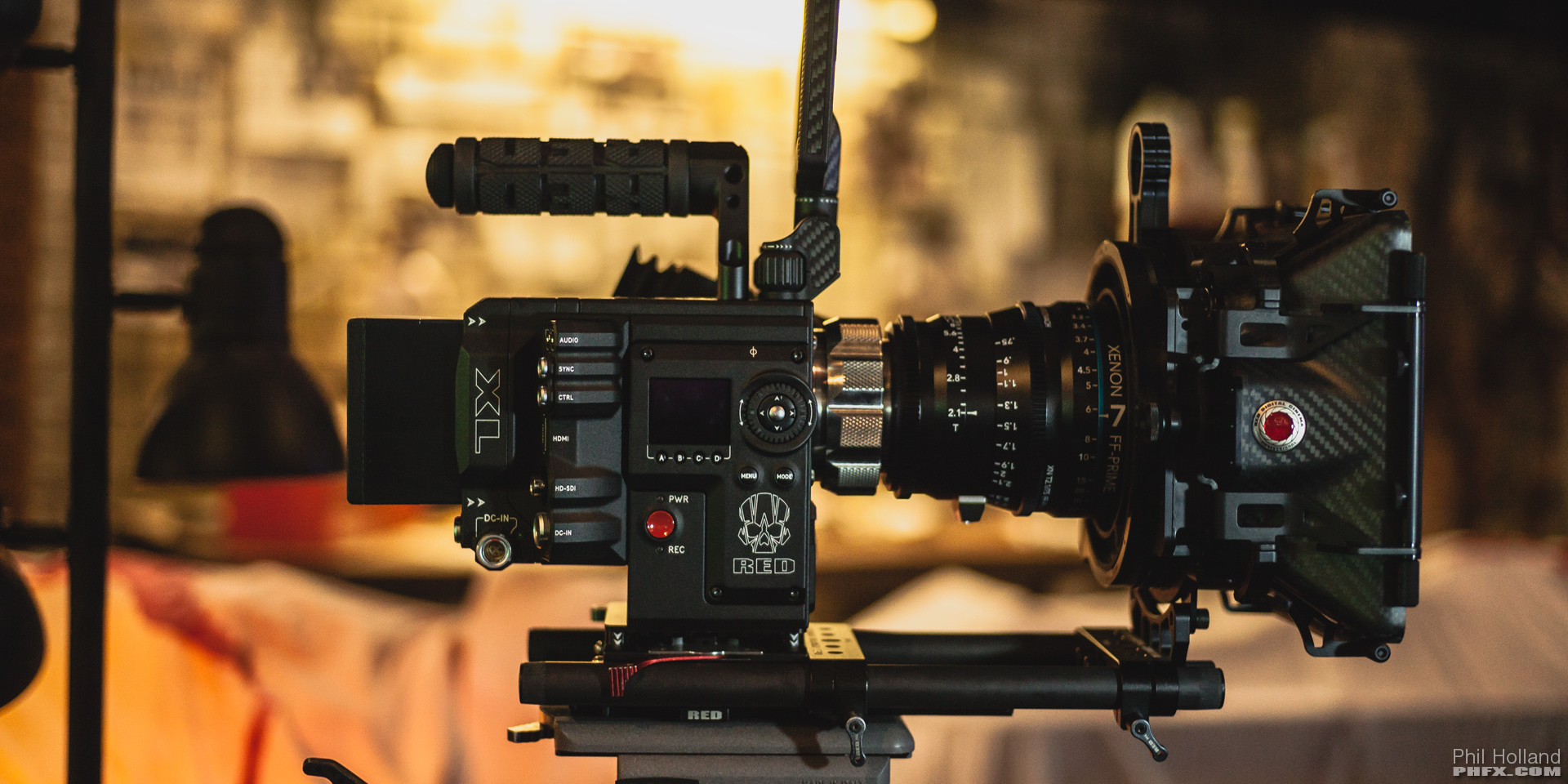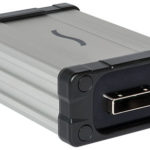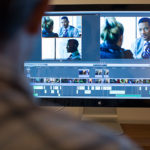
The RED 8K Revolution
Posted on Apr 24, 2015 by Alex Fice
The RED Dragon 8K in a Weapon Carbon Fiber Brain. Due out sometime this year. © www.phfx.com
We asked Phil Holland, LA DoP, why 8K for RED and why the Weapon.
Q. What do you know about the 8k Weapon?
A: At NAB 2015 RED announced their new Weapon camera which features the RED Dragon sensor technology. There were three models announced at the show. The Weapon 6K Carbon Fiber, the Weapon 6K Magnesium, and the upcoming Weapon 8K Carbon Fiber. RED Weapon represents a great deal of effort to produce an extremely compact fully fledged high end production camera.
It features a host of new technology like a smaller/lightweight body design, simultaneous recording of REDCODE RAW and ProRes Quicktimes onto the same media, 3D LUT Support, WiFi, higher data rates, increased internal bandwidth, increased processing power, new “cableless” EVF/LCD connections, newly designed top fans, newly designed camera ventilation, new module attachment system, new more powerful compact modules, built in scratch microphones, and vastly improved Black Shading “auto” calibration. And there’s even more than that, but the simple explanation is the Weapon camera body is a step into the future.
I like to think about Weapon as the evolution of RED’s DSMC (digital stills and motion camera) concept they introduced with the Epic and Scarlet camera “brains” (bodies). With Weapon we have a move into “DSMC 2.0” and there’s a great deal of forward thinking technology with features that productions and shooters have been asking for. Certainly not an entry level camera, but 100% a production workhorse.
Q: Is there an upgrade path to it?
A: RED Weapon is available as an upgrade to all Dragon sensor RED cameras. Which means primarily RED Epic, Epic Carbon Fiber, and Scarlet cameras that currently have the Dragon sensor in them. Also, you can purchase a new Weapon 6K Carbon Fiber body as well. Both of these programs begin Summer 2015. At the moment Weapon 8K Carbon Fiber is only being offered as an upgrade from Weapon bodies and that program begins late 2015.
RED rewards it’s customers and “early adopters” and for those Dragon owners who purchased before NAB 2015 there are various trade-in credits and accessory credits that have been offered.

Weapon at NAB 2015. © www.phfx.comQ: Does 8K makes sense outside of Japan where they plan to broadcast it?
A: 8K doesn’t exclusively exist in Japan, though they are very focused on bringing 8K broadcast to life. A long while ago the UHD and DCI specifications were defined for 4K and 8K productions. Before that we were scanning film in at 4K, 6K, and 8K resolutions for 4K laser recording from the mid 90s through the 2000s. What you are seeing is “more 8K on the rise” at the moment. In Japan they will be starting their first 8K broadcast trials in 2016 and their focus is to broadcast the 2020 Olympics in 8K as well.
For me as a filmmaker there’s more going on here however. The Weapon 8K Dragon sensor is approximately the size of one of my favourite motion picture formats called “VistaVision”. I’ve been waiting for over a decade for a digital cinema VistaVision camera to come to market to explore this format for theatrical releases and now our new higher resolution UHD 4K and 8K televisions. RED found something special with the Dragon sensor technology that provided a lot of “film relevance” in how it performed. We’ve known for some time in the industry that Super 35mm film resolves about 4-5K of resolution and Dragon provides 5K resolution in the approximate Super 35mm format size. Additionally Dragon has a very high dynamic range of 16+ stops, vastly improved colour rendering, and nearly no “digital thumbprint” to it’s smooth highlight roll-off. RED long ago set forward the notion of a “digital film alternative” with their cameras starting with the RED One and original M sensor. However, with Dragon they’ve truly hit and exceeded that goal as we are surpassing several of the technical merits of film for the first.
The allure of 4K and 8K resolution for me stems from a simple concept I like to call “The Window Effect”. The general idea is that at these higher resolutions and generally higher quality image the audience’s viewing experience brings them “closer” to the content by removing more of the “digital divide” and awareness of them knowing/feeling that they are looking at a tablet, television, or silver screen. Essentially 4K and 8K brings them to the worlds and stories we are creating quicker and in a much more beautiful and vibrant way. Combined with some of the other technological developments like HDR displays, Laser Projection, and dense 300-600PPI screen technology people will be seeing content in a way they’ve never experienced before and it will feel much more real than ever.
Q: Would this be REDs IMAX camera? Are there any other roles for it?
A: Dragon 6K found on Epic Dragon cameras has already been used for IMAX productions and 8K capture and projection will be perfect for the “pure IMAX experience”. IMAX cameras are actually 15-perf 70mm film and feature a very large film negative imaging plane. The 8K Dragon Sensor found in Weapon is a bit larger than the VistaVision format, which is a bit smaller than 15-perf IMAX. However, the pixel resolution will likely match or exceed what viewers have experienced before, especially when it comes to IMAX digital projection.
I personally think and hope that 8K projection comes to more theatres as it will produce a tremendous “movie going” experience. If combined with things like Dolby’s new Atmos system for sound and 4K and 8K Laser Projection audiences will have very immersive experiences. 8K will also make it into homes. 4K and 8K are basically the industry’s newest standards and we’ll be making content for 4K and 8K for years to come.
This extra 8K resolution doesn’t just have “display” benefits, but it’s also something to creatively explore as a “problem solver” from the shooter’s perspective. Having more captured resolution than your finishing resolution allows for things like post stabilisation, format cropping, and reframing to occur without a loss visual quality. A good recent example of this is David Fincher’s Gone Girl which shot RED Epic Dragon 6K and used that extra resolution for some of those post production techniques I mentioned.

RED Dragon. © www.phfx.comQ: How would data rates be handled? Would there be new Red Rocket hardware? New cards? Whole new post systems?
A: That’s actually the good news really. For those working with RED 5K and 6K Dragon cameras this jump to 8K won’t be a “big deal” at all. The current RED ROCKET-X will work with Weapon 8K material as well as the GPU Acceleration supported by RED, Adobe, and other software manufacturers.
Weapon does require the newer MINI-MAGs that were released a bit ago to support the higher data rates and resolutions as well as the simultaneous ProRes recording.
As for post systems and upgrading those, just depends. If you have a system that’s working for a Dragon 6K workflow today there likely won’t be a big reason for a fully system overhaul when 8K arrives. VFX and Post Houses will have to manage the file size of DPX image sequences at these higher resolutions for post, but houses like Light Iron are already ready for this 8K workflow.
Q: Is an 8k camera this year plausible?
A: If everything goes according to plan the first Weapon 8K Carbon Fiber cameras with the Dragon sensor will ship at the end of the 2015. At NAB 2015 there were several of the 8K models at the RED booth and 8K footage was also shot on the show floor with one of those cameras. So I’d say very plausible.
Q: Is 8K one of the main reasons Weapon has been produced? Weapon is the new brain for the future sensor upgrades?
I’d say the biggest reason for Weapon 6K and 8K being produced comes down to production’s and shooter’s wants, needs, and desires. RED has a very open door of conversation with it’s shooters working on productions of all budget levels and they’ve clearly listened to many of the “feature requests” that people have wanted over time. Weapon is the result of that customer feedback and you can see that in its body design and feature set. You can literally hold a Weapon camera body in the palm of your hand and it’s actually scary impressive of just what that little camera body can do. RED’s been working hard on developing Weapon for some time and we are seeing the fruits of those efforts with this new camera.
As for a future sensor upgrade? It’s hard to say exactly what RED has in store for shooters in the future. One thing is for sure, every RED Dragon camera will have an upgrade path to the “future”. What we are seeing with Weapon is mostly the introduction of their top of the line camera body following by Epic and Scarlet Dragon bodies.

RED Weapon at NAB 2015. © www.phfx.com.Q: What else is new about Weapon? Does it makes sense for you to invest?
A: For me personally the 8K resolution VistaVision+ sensor size of Weapon 8K is something that’s very alluring as Director and Director of Photography. However, I also work primarily in the world of Visual Effects, feature Films and productions that are concerned about creating the “best possible” image. That extra resolution will be incredibly useful for VFX applications as a tool. 8K also represents another step in “future proofing” content which makes a lot of sense for certain productions. There will also be some visual image quality improvements due to the added bandwidth and processing power on Weapon, and that’s a factor as well. Generally speaking, the biggest incentive for me to invest in the Weapon camera and upgrade comes down to providing my clients, studios, and productions more of what they’ve been asking for. Being able to offload ProRes files quickly at the time of REDCODE RAW capture is going to be very important to some shooters. DITs can spend less time transcoding if certain on set workflows are explored. That saves everybody time and money really.
Q: What have RED said about the future of their cameras at NAB?
A: The focus for RED this year at NAB 2015 was Weapon 6K and 8K. As well as showing off more 4K Broadcast functionality using things like Epic Dragon and the REDCAST Module. 4K was everywhere at the show and we saw more 8K at NAB than ever before. In many ways RED’s been leading the way on helping push 4K and 8K technology forward and they’ve been “the early bird” consistently. As for the future of their cameras and what’s to come on the horizon it’s too soon to tell. However, before NAB 2015 RED announced several official vendors, authorised rental houses, and even opened up the RED Store Miami strengthening their national and international support and availability of their gear. This is actually something that’s very important for a shooter like me as I mostly work in Los Angeles, but I have had four jobs in the last year that have taken me outside of the USA to shoot elsewhere in the world. Having that global support provides much more confidence when I need to kit up abroad or if I drop a camera in the ocean, which I haven’t done yet (knock on wood).
Q: The look of RED seems to be getting better. Are the new sensors markedly better and the ways R3D is being handled?
Yes and that’s something productions have noticed as well. This is largely due to the Dragon sensor and what features it provides. People see 8K, 6K, and 5K resolution often without taking into account the format size, but for motion picture professionals having that film format to resolution relevance is rather important as it “is” part of the way those making films with actual film who might be making the transition to digital cinema cameras work. It effects the look, the lenses, and general shooting methods. However, the biggest thing really is Dragon’s colour. It’s providing some of the best colour we’ve ever seen out of a sensor and that’s due to improved Colour Science, vastly improved Infrared Cutting/Blocking, and the sensor’s very high Dynamic Range of 16+ stops. That Dynamic Range plays a role into the more natural Highlight Roll-Off. The combined efforts of all of these things has produced a very “film-like” digital image that is very flexible to work with.
We’re at a special moment right now with RED digital cinema cameras with this newer Dragon sensor. It’s become as familiar as shooting film and it’s producing on par or even surpassing the image quality of shooting on film. RED makes cameras that are “multi-format” systems, much like film was never “one format”. With the upcoming Weapon 8K Carbon Fiber body using that Dragon sensor we’ll have digital equivalents of VistaVision, Super 35mm, and Super 16mm with resolution to format size relevance. Which also means if you are using glass designed for those formats you get what you’d be looking for as well. Creatively that’s exciting because you might want to use 8K Vista Vision for one production or scene and film at 5K Super 35mm for the rest of your production for a 4K finish. There’s just so many exciting possibilities to explore.
Phil Holland is a Director and Director of Photography based out of Los Angeles, California and has shot exclusively in the 4K and 4K+ arena for several years. He primarily works in the world of feature films, commercials, UHD broadcast, and visual effects heavy productions. Phil is focused on cutting edge cinema technology and creating compelling images. Prior to becoming a full time cinematographer Phil worked at Rhythm and Hues Studios from 1999-2010 as their Digital Imaging Specialist; a job title that focused on photography, cinematography, digital colour, 4K/6K film scanning/recording, and other aspects of visual effects productions.








